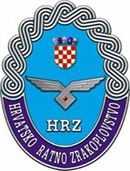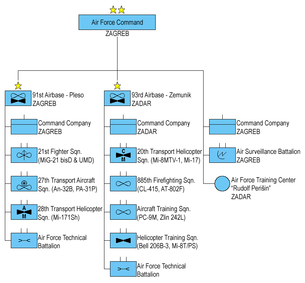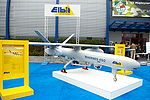- Croatian Air Force and Air Defence
-
Croatian Air Force and Air Defence
Emblem of the Croatian Air Force and DefenceActive 1991 Country Croatia Size about 2,000 personnel
92 aircraft,H/Q Pleso Airbase, Zagreb Motto Hrvatskim nebom bdiju i plove (Croatian Sky they Guard and Fly) Anniversaries December 12 Engagements Croatian War of Independence:
* Siege of Dubrovnik
* Operation Maslenica
* Operation Winter '94
* Operation Flash
* Operation Storm
Bosnian War
* Operation Mistral
KFORCommanders Current
commanderbrigadier general Dražen Šćuri (acting) Notable
commandersGeneral Imra Agotić, General Josip Ćuletić, Major General Josip Štimac, Major General Viktor Koprivnjak, major general Vlado Bagarić Insignia Roundel 

Fin Marking 

Aircraft flown Fighter MiG-21BisD/UMD Patrol Bell 206B-3, Pilatus PC-9M Trainer Pilatus PC-9M, Zlin 242L, Bell 206B-3 Transport An-32B, Mi-8 MTV-1, Mi-171Sh Croatian Air Force and Air Defence (Croatian: Hrvatsko ratno zrakoplovstvo i protuzračna obrana) is a branch of the Croatian Armed Forces.
Aviation history
Main article: History of the Croatian Air ForceSome of the first aviation pioneers were from Croatia or of Croatian descent. Faust Vrančić designed and successfully tested the parachute in 1617. First Croat flying in a balloon was Krsto Mazarović over Zagreb in 1789. David Schwarz created the first flyable rigid airship. Slavoljub Eduard Penkala constructed the first Croatian two-seat airplane in 1909 which Dragutin Novak, the first Croatian pilot, used for his first flight. Katarina Matanović-Kulenović was the first female Croatian pilot and parachutist.
The Croatian Air Force as it is known now was established on 12 December 1991, during the Croatian War of Independence. After 2003 almost the whole fleet was modernized or completely overhauled. Croatia is now expecting new helicopters and fighters to enter service in the near future, enabling the military to operate much needed up-to-date technology.
Duties
The primary role of Croatian Air Force and Air Defence is securing sovereignty of Croatian air space and providing air support to other services during joint operations. It is a proponent and organizer of the Croatian air defence integrated system. This double role of the Croatian Air Force and Air Defence is realized with the following main tasks:
- Inspection and control of air space security
- Predominance in Croatian air space, over land and sea, with defence and attacks
- Providing help in natural, humanitarian and technological disasters
- Search and rescue operations
- Support to control of the proliferation of people and material goods
Commanders
Commanders of the Croatian Air Force since its establishment in 1991:
- Imra Agotić
- Josip Čuletić
- Josip Štimac (2001–2002)
- Viktor Koprivnjak (2002–2007)
- Vlado Bagarić (2007–present)
Structure [1]
- Air Force Command
- Command company
- 91st Air Force Base - Pleso, Zagreb
- Command company
- 21st Fighter Squadron - MiG-21bisD/UMD
- 27th Transport Aircraft Squadron - An-32B
- 28th Transport Helicopter Squadron - Mi-171Sh
- Air Force Technical Battalion
- 93rd Air Force Base - Zemunik, Zadar
- Command company
- 20th Transport Helicopter Squadron - Mi-8MTV-1
- 885th Firefighting Squadron - CL-415, AT-802
- Fixed-Wing Aircraft Squadron - PC-9M, Zlin 242L
- Helicopter Training Squadron - Bell 206B-3, Mi-8T
- Air Force Technical Battalion
- Air Surveillance Battalion
- Air Force Training Center
Status
 Croatian fighter pilot puts on his Russian ZSh-5 helmet as he walks towards his MiG-21
Croatian fighter pilot puts on his Russian ZSh-5 helmet as he walks towards his MiG-21
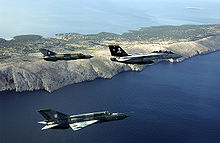 Croatian MiG-21bis and US Navy F-14B Tomcat over Adriatic sea
Croatian MiG-21bis and US Navy F-14B Tomcat over Adriatic sea
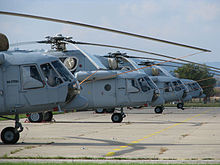 Mi-171Sh at Lučko AFB
Mi-171Sh at Lučko AFB
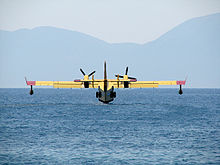 Canadair CL-415 filling tanks with water
Canadair CL-415 filling tanks with water
The core of the air force is a squadron of 10 modernized MiG-21bisD/UMD fighters (two single-seaters lost in a mid-air collision on September 23, 2010) which are scheduled to be retired by 2013. In 2003, a minor upgrade and an extensive overhaul was performed in Romania, incorporating some of the elements of the Lancer standard, primarily to make them interoperable with NATO air forces. Their replacement was expected in 2011 when a squadron of new multirole fighters was to have entered service. An official tender calls for 12 aircraft. In late 2007 requests for proposals were issued to the users and manufacturers of the Saab Gripen, F-16, Mirage F-1, Eurofighter and MiG-29. All responded by March 2008 and the final decision was expected in late 2008 or early 2009. The Mirage F1 was not considered a serious contender as it is an obsolete fighter and does not fulfill Croatian AF requirements. However, in November 2008 the Croatian government decided to postpone the tender due to the worldwide economic crisis.[2]
Analysis of technical proposals for multipurpose fighter aircraft were continued in 2009 and 2010. There were presentations held, and MoD continues to gather additional information about the aircraft while preparing feasibility studies for the multipurpose fighter aircraft.[3] Competitors are Saab JAS 39 Gripen, Eurofighter Typhoon, Dassault Rafale, General Dynamics F-16 Fighting Falcon and Mikoyan MiG-35.[4][5] Final decision on the purchase will be brought by mid-2011. This is considered to be the latest possible date by which time the decision must be made if Croatia wants to maintain its continuous fighter capability. Pilot training is conducted on two types of aircraft. During late 2007, five new Zlin 242L Aerobatic basic trainers were acquired in order to replace seven old Utva 75. The deal was worth just under $2 million. Due to a moderate expansion of the force, three additional Zlins are on option. The backbone of the training fleet is built around 20 Pilatus PC-9M advanced trainers which also represent the most numerous type of aircraft in Croatian service. These were ordered in 1997 and entered full service a year later. The whole deal was worth around $100 million. They are also operated by the national aerobatic team called Krila Oluje / Wings of Storm. As Croatia does not plan to obtain lead-in-fighter trainers, the whole fleet is to be modernized around the same time the new fighters enter service. The modernization is expected to include HUDs, HOTAS and possibly the installation of unguided weaponry, in an effort to ease the process of advancing from turboprop trainers to multirole fighters.
Croatian Air Force operates two Antonov An-32B tactical transports which underwent a two-stage modernization in 2004 and 2007. They were fitted with new navigational and communication equipment, additional systems facilitating loading/unloading, flare dispensers etc. However, at least two larger cargo aircraft are needed and are to join or replace Antonovs around 2015. Certain rumours suggest second-hand C-130 Hercules from USAF. After some delays, on April 20, 2009, one An-32B flew for the first time to a mission to Afghanistan and returned five days later. After that, several successful flights have been made to Baghdad and Kabul.
The helicopter fleet is equipped mainly with Russian-built Mi-17s and its derivates. The fleet includes three Mi-8 and 11 Mi-8MTV-1 (also known as Mi-17-1V) cargo helicopters, which underwent an overhaul in 2005 and 2006.
In 2006, a deal to deliver 10 new Mi-171Sh transport-attack helicopters was signed with Russia. This was a part payment for an old debt worth $186 million Russia owed to Croatia. The order itself is worth $66 million. The new type differs from the ones already in service in having a cargo ramp instead of clamshell doors, larger side doors, flare dispensers, additional armor around the cockpit and cargo compartment, night vision device equipment, door gunner posts, rocket launchers etc. The entire squadron of 10 helicopters entered service by July, 2008. Two additional VIP helicopters were planned for 2009 but their acquisition has also been postponed.
After more than 10 years in the Croatian service and great success in Operation Storm, the government finally decided to retire a squadron of seven Mi-24V helicopters in 2005 due to a costly modernization. Six are offered for sale at a price of $83,000 per aircraft, while one was sent to a museum. Plans for a new type of attack helicopter do not exist although these kinds of aircraft are definitely needed. The role of an armed support helicopter was taken over by new Mi-171s. In 2007, Croatia was very near to selling its Mi-24s to Georgia but due to Vladimir Putin's disapproval and danger of ruining good relations with Russia, the deal was not finalized.
While visiting Israel in November 2006, Croatian delegation agreed to buy two mid-size, state-of-the-art Hermes 450 and four small Skylark UAVs. Additional cameras, computer systems, spare parts and a ground station were also obtained. The Hermes 450s will be used mainly for maritime patrol. Two additional Skylark UAVs are to enter service in 2009 and further purchases are expected.
After a horrible fire season during the summer of 2007 (12 firefighters lost their lives on a small island of Kornati), Croatia agreed to buy two new Canadair CL-415 and five Air Tractor AT-802 water bombers. These will join a fleet of five relatively new amphibians already in service. The entire deal is projected at $70 million. By making such an acquisition, Croatia became the leading power in aerial firefighting on the Mediterranean in respect to its population and surface.
MiG-21 replacement acquisition
Due to the global economic crisis which also affected Croatia, the decision on which fighter type should eventually enter service has been deferred until 2011, rather than by 2009 as was initially planned. This will see new aircraft enter service no sooner than 2012-2013. At the same time, after years of research and discussions, Air Force experts have released the study on new fighter procurement which states that Croatian Air Force needs at least 16 to 18 fighters in order to fulfill all its duties. As an interim solution the possibility of reactivating six to seven MiG-21s (out of 12 stored a few years ago) was mentioned in 2009 by some media. Similarly, there was also the possibility of one additional overhaul to the existing MiGs which was to prolong their life for another five years facilitating thus the burden of the fighter procurement costs on the country's budget. However, this possibility was officially rejected and on April 11, 2011 the Minister of Defence confirmed that Croatia will maintain a fleet of fighter aircraft and that it will not relegate its airspace control to any of the NATO membering countries. He also added that the decision on which aircraft to obtain will be brought in the upcoming months but having in mind not only the needs of the military but also of the entire country's economy.
In March 2011 a new information appeared in the Croatian media citing that Germany was prepared to donate (or sell cheaply) up to 20 of its F-4 Phantom II fighters to Croatia[6]. Soon after, a similar offer was proposed by the Swedish Air Force which is willing to donate a squadron of its second-hand Saab Gripen aircraft free of charge to match German offer[7]. Both proposals along with numerous other possibilities are currently under revision.
Modernization and procurement programs 2007 - 2015
- Procurement of five Zlin 242L basic trainers. Program completed with five aircraft delivered in late 2007. Additional units may be acquired. Cost of program - 8 million Croatian Kuna.
- Procurement of two additional Canadair CL-415 fire bombers and five amphibious Air Tractor AT-802. Program completed with all five AT-802 delivered in 2008 and 2 CL-415 ordered for 2009. Cost of program - 340 million Croatian Kuna. It has to be noted that these procurements were not planned and the funds were allocated from a surplus in the national budget.
- Procurement of 10 to 12 Mi-171Sh transport-attack helicopters and all associated spare parts and equipment. Program completed with 10 units delivered by July, 2008. Additional 2 units are planned. Cost of Program - 330 million Croatian Kuna paid in exchange for a Russian debt to Croatia.
- Procurement of modern jet fighters. Croatia plans to modernize its air force by introducing 12 multirole fighters. In the competition are Saab JAS 39 Gripen, Eurofighter Typhoon, Dassault Rafale, General Dynamics F-16 Fighting Falcon and Mikoyan MiG-35.[4][5] Cost of program - 5,000 million Croatian Kuna.
- Procurement of 2-3 medium-size cargo aircraft. The details of the program are not known yet but second-hand aircraft are more probable. Cost of program - unknown.
- Procurement of Advanced short-to-medium range NATO SAM systems and modernization of existing Russian-made 9K38 Igla SAMs. Croatia needs 12 short-to-medium range SAM batteries. Cost of program - 700-850 million Croatian Kuna.
- Modern Radar network. New modern Radar network was put in to use in 2007 - AN/FPS-117 Radar network consisting of 5 radar stations across Croatia. Cost of program - 1,800 million Croatian Kuna, program was initiated in 1998 and paid for by Croatian MOD in 1999.
- Additional programs are also being considered - additional utility, ASW, SAR and police helicopters.
- Modernization costs will total €1,157 million, equivalent to US$396 per Croatian citizen.
Current aircraft inventory
Aircraft Photo Origin Type Versions In service[8] Serial numbers Notes Fighter Aircraft Mikoyan-Gurevich MiG-21 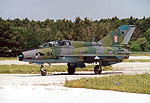
 Soviet Union
Soviet Unionfighter/interceptor
fighter trainer
fighter/interceptorMiG-21bisD
MiG-21UMD
MiG-21bis6
4
12115-118, 121, 122
164-167
-All aircraft produced 1972-1981 and entered service 1992-1994. Eight single seaters and 4 twin-seaters modernized in 2003, two single seaters lost in a training accident. Expected withdrawal in 2013. Additional 12 MiG-21bis are in storage and not currently airworthy. Trainer Aircraft Pilatus PC-9 
 Switzerland
Switzerlandadvanced trainer PC-9M 3
17051-053
054-070Three second-hand PC-9/A acquired from RAAF in 1997, modernised to PC-9M. All PC-9M's are produced in 1997 and enetered full service in 1998. Zlin 242 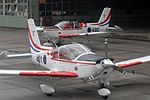
 Czech Republic
Czech Republicbasic trainer 242L Aerobatic 5 401-405 All aircraft produced and entered service in late 2007. Aerial Firefighting Aircraft Air Tractor AT-802 
 United States
United Statesfirefighting, coastal patrol AT-802F
AT-802AF
AT-8021
1
4890
896
892-895All aircraft (except one) produced and entered service in 2008. Canadair CL-415 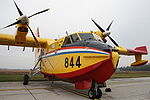
 Canada
Canadafirefighting CL-415 6 811, 844-888 Aircraft acquired new in 4 batches from 1999 till 2010. Transport and Liaison Aircraft Antonov An-32 
 Ukraine
Ukrainetactical transport An-32B 2 707, 727 Both aircraft produced in 1992 and entered service in 1996. Modernized in two stages, in 2004 and again in 2007. Bombardier Challenger 600 
 Canada
CanadaVIP transport CL-604 1 CL600-2B16 Government aircraft on civilian register, used also for urgent medical transport. UAV's Elbit Skylark 
 Israel
Israelreconnaissance Skylark I 6 - Acquired in 2007 and 2008, more to be ordered, used by the Army. Elbit Hermes 450  Israel
Israelreconnaissance Hermes 450 2 - Acquired in 2007. Transport and Utility Helicopters Mil Mi-17 
 Russia
Russiacombat-support helicopter
transport helicopterMi-171Sh
Mi-17-1V10
12220-229
201, 202, 204, 206, 207, 211-215, 217, 251Acquired new and entered service in 2008, aka Mi-8AMTSh.
Most units acquired new 1992-1994, aka Mi-8MTV-1.Mil Mi-8 
 Soviet Union
Soviet Uniontransport helicopter Mi-8T 3 274-276 Utility transport variant. Bell 206 
 United States
United Statestraining helicopter, light utility 206B-3 8 602-608, 610 Entered service in 1997. Aircraft that have been retired
- 20 Mikoyan-Gurevich MiG-21- used for spare parts
- 2 Soko G-2 Galeb - retired in 1996 due to the lack of spare parts
- 1 Soko J-21 Jastreb - retired in 1996 due to the lack of spare parts
- 1 Soko J-20 Kraguj - retired due to overall obsolescence in 1996
- 1 Lola Utva 60 - retired in 90's
- 4 Lola Utva 66 - retired in 90's
- 11 Lola Utva 75 - put out of service recently, replaced by Zlin 242L
- 3 Canadair CL-215 Scooper - last retired in 2004, replaced by Canadair CL-415 Superscooper
- 2 Air Tractor AT-400 - retired in 1993
- 1 Dornier Do 28 - retired in 2004
- 1 Dassault Falcon 10 - replaced by Bombardier Challenger
- 11 Antonov An-2 - handed over to aeroclubs throughout the years, some can be called into service
- 4 Cessna 172 - retired in 1997
- 2 Cessna A.188B Agwagon - retired in 1992
- 1 Cessna T.210N Centurion - retired in 2004
- 4 Piper PA-18 Super Cub - retired in 1996
- 2 Piper PA-25-235 Brave - retired in 1992
- 3 Piper PA-28 Warrior - retired in 1997
- 1 Piper PA-31P - retired in 2005
- 2 Piper PA-36 Pawnee Brave - retired in 1992
- 2 PZL M-18 Dromader - retired in 1992
- 9 Mil Mi-24D/V - withdrawn in 2002 (Mi-24D) and 2005 (Mi-24V), 6 up for sale
- 7 Mil Mi-8T/S - used for spares
- 3 Agusta Bell 212 - transferred to the Croatian Police
- 4 MD Helicopters MD 500 - last retired in 2001, replaced by Bell 206
- 1 Agusta-Bell AB.47J-2A - returned to museum in 1992
Aircraft lost in combat and accidents[9]
- YU-BKB crashed on 9 November 1991 (take-off accident)
- YU-BOP downed 2 December 1991 (SA-6), pilots Marko Živković and Mirko Vukušić, parachutists Ante Plazibat and Rade Griva killed
- YU-BOF crashed 26 January 1992 (training accident), pilots Branko Fridel, Bojan Vojvoda, Mladen Škalica, mechanic Boris Kekez and parachutist Davor Šabić killed
- 101 downed 24 June 1992 (friendly fire SA-14), pilot Antun Radoš killed
- 103 downed 14 September 1993 (SA-7), over Gvozd (then Vrginmost), pilot Miroslav Peris killed
- 104 crashed on 21 April 1995 (tree accident), pilot Zlatko Mejaški killed
- 119 downed 2 May 1995 (20/3 mm AA gun), over Stara Gradiška, pilot Rudolf Perešin killed
- 109 crashed on 14 August 1996 (lost orientation), pilot Ivan Bosnar killed
- 108 and 120 crashed near Slunj on 23 September 2010 after a collision over Vukelići village, both pilots ejected safely
- 891 crashed on 2 September 2004 (tree accident)
- HT-40 downed 4 November 1991 (friendly fire), Lučko Airport[10]
- H-208 crashed on 26 February 1993
- H-209 burned at ground 4 December 1994 (Lučko Airport)
- H-205 crashed on 22 November 1995 (freezing of the rotor)
- H-253 crashed on 18 September 1997 (lost orientation)
- H-207 crashed on 20 July 2004 (taxi accident)
- H-214 (new H-253) crashed on 10 July 2007 (technical failure), Juraj Ruškač, Vjekoslav Ljubo and Ljubica Perišić killed on ground
- H-309 accident on 10 June 1995 (weather conditions/stall), destroyed on the ground to avoid capture
- one lost in transport on January 1994 (hooked under Mi-8)
- H-601 crashed on 16 October 1997 (accident at hover)
- H-609 crashed on 12 February 1998 (pilot error), killed Šime Ražnjević on ground
Enemy aircraft destroyed by the Croatian Air Force and Defence[11]
- MiG-21, 1991, Đakovo
- G-2, 5 August 1991, Zadar
- J-21, 24256, 24 August 1991, Vukovar/Bršadin
- J-21, 24 August 1991, Bogdanovci
- J-21, 7 September 1991, Bršadin
- J-21, 7 September 1991, Vukovar
- J-21, 24136, 16 September 1991, Osijek/Donji Miholjac
- J-21, 24116, 17 September 1991, Tenja
- G-4, 23603, 17 September 1991, Vukovar/Sarvaš
- MiG-21, 17109, 18 September 1991, Ogulin
- J-21, 18 September 1991, Rogoznica
- MiG-21, 18 September 1991, Petrinja
- J-22, 25508, 19 September 1991, Đakovo
- J-22, 19 September 1991, Novska
- J-21, 20 September 1991, Šibenik[12]
- G-2, 23254, 20 September 1991, Kornati
- G-2, 23264, 20 September 1991, Brač
- G-2, 20 September 1992, Žirje
- Gazelle, 20 September 1991, Split
- J-21, 21 September 1992, Primošten
- G-4, 24 September 1991, Vukovar
- G-4, 23733, 24 September 1991, Lički Ribnik
- J-20, 30141, 3 October 1991, Konavle
- Mi-8, 12245, 4 October 1991, Slavonski Brod
- Gazelle, 5 October 1991, Konavle
- MiG-21, 17130, 6 October 1991, Slunj
- J-21, 17 October 1991, Ston
- J-21, 24268, 4 November 1991, Vukovar/Kisač
- MiG-21, 26111, 8 November 1991, Delnice/Ravna Gora
- G-2, 8 November 1991, Zadar
- MiG-21, 17156, 9 November 1991, Đakovo/Vrpolje
- G-4, 23734, 9 November 1991, Vinkovci/Bačka Palanka (Serbia)
- J-21, 24414, 12 November 1991, Sinj
- J-21, 15 November 1991, over the sea
- G-4, 23631, 24 April 1992, Neum (Bosnia and Herzegovina)
- MiG-21, 26109, 12 April 1992, Kupres (Bosnia and Herzegovina)
- J-21, 24201, 13 April 1992, Bosanski Brod (Bosnia and Herzegovina)
- J-21, 23 April 1992, Čapljina (Bosnia and Herzegovina)
- J-21, 24 April 1992, Cerovica (Bosnia and Herzegovina)
- MiG-21, 17152, 2 May 1992, Slavonski Brod
- J-22, 25105, 28 June 1992, Odžak/Modriča (Bosnia and Herzegovina)
- Mi-8, 12402, 17 July 1992, Gradačac (Bosnia and Herzegovina)
See also
- History of Croatian Air force
- Air Force of the Independent State of Croatia
References
- Lisko, T. and Canak, D., Hrvatsko Ratno Zrakoplovstvo u Drugome Svejetskom Ratu (The Croatian Airforce in the Second World War) Zagreb, 1998 ISBN 953-97698-0-9.
- Savic, D. and Ciglic, B. Croatian Aces of World War II Osprey Aircraft of the Aces - 49, Oxford, 2002 ISBN 1-84176-435-3.
Notes
- ^ http://www.morh.hr/katalog/documents/spremnosti%20obrambenog%20sustava%202008.pdf[dead link]
- ^ Croatian fighter tender cancelled
- ^ Godišnje izvješće o spremnosti obrambenog sustava za 2009. godinu (Croatian)
- ^ a b Saab details Gripen proposal to Croatia by Dino Kucic
- ^ a b Fighters - from boom to gloom?
- ^ Hrvatska korak bliže nabavi borbenih aviona F-4 Phantoma ("Croatian")
- ^ Sweden Offers Gripen to Croatia
- ^ Croatian military aviation OrBat
- ^ Chronological Listing of Croatia Losses & Ejections
- ^ http://hrcak.srce.hr/file/17412
- ^ Chronological Listing of Yugoslav Losses & Ejections
- ^ J-21 shot down over Sibenik caught on video
External links
- Official website (English version)
 Croatian Army •
Croatian Army •  Croatian Navy •
Croatian Navy •  Croatian Air Force and Air Defence
Croatian Air Force and Air DefenceLeadership Commander-in-chief: President of Croatia • Minister of Defense • General Staff of Croatia
Organization BranchesCommandsSupport Command • Training and Doctrine Command • VSOA
ForcesBSD • Motorized Guards • Armoured Guards • Navy Flotilla • Coast Guard
Military history Army history • Navy history • Aviation history
Uniforms and Insignia Uniforms • Ranks • Orders and medals
Air forces in Europe Sovereign
states- Albania
- Andorra
- Armenia
- Austria
- Azerbaijan
- Belarus
- Belgium
- Bosnia and Herzegovina
- Bulgaria
- Croatia
- Cyprus
- Czech Republic
- Denmark
- Estonia
- Finland
- France
- Georgia
- Germany
- Greece
- Hungary
- Iceland
- Ireland
- Italy
- Kazakhstan
- Latvia
- Liechtenstein
- Lithuania
- Luxembourg
- Macedonia
- Malta
- Moldova
- Monaco
- Montenegro
- Netherlands
- Norway
- Poland
- Portugal
- Romania
- Russia
- San Marino
- Serbia
- Slovakia
- Slovenia
- Spain
- Sweden
- Switzerland
- Turkey
- Ukraine
- United Kingdom
- Vatican City
States with limited
recognition- Abkhazia
- Kosovo
- Nagorno-Karabakh Republic
- Northern Cyprus
- South Ossetia
- Transnistria
Categories:- Military of Croatia
- Air forces by country
- Aviation in Croatia
- Military units and formations established in 1991
Wikimedia Foundation. 2010.

